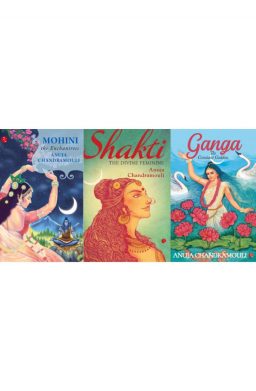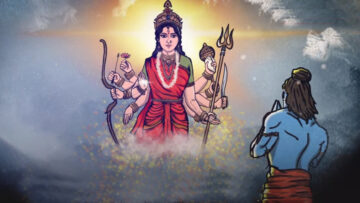The world of Puranas and Epics is a fascinating saga of ancient knowledge, myths, legends and records of historical events that keeps the reader mesmerized and spell bound. It has devas and asuras, demigods and supreme gods, kings and heroes, saints and sages, apsaras and gandhravas, ordinary men and women, animals and plants, mountains and rivers, all knit together through stories and tales that impart valuable moral and ethical lessons.
Anuja Chandramouli takes us inside this world by telling the tales of three goddesses Mohini- the enchantress, Shakti- the divine feminine and Ganga- the constant goddess. Through their trials and tribulations, struggles and victories, desires and hopes, she shows us how everything in the cosmos is intricately bound together to maintain the equilibrium so that peace and prosperity prevail all over the three worlds.
Men, gods and demons blinded by their egos, greed and ambition keep disturbing this cosmic equilibrium causing tremendous suffering, decay and degradation all around. Supreme Gods and Goddesses, moved by the plight of innocent creatures and by virtue of their better knowledge and understanding of the events, act directly or take avatars to restore the equilibrium.
But even Supreme Gods and Goddesses are limited by the laws of Karma. Ultimately it is the immutable laws of Karma which set in motion the events which then run their own course.
In Mohini, the Enchantress, Anuja Chandramouli tell us the story of goddess Mohini. She is variously described as the only female avatar of Supreme God Vishnu or the feminine aspect of Vishnu whom he creates out of his own essence when the masculine aspect is unable to fulfill the task at hand.
Asuras should not partake of Amrit obtained by the churning of oceans so as to maintain the balance of power between devas and asura. But who will deny the asuras the Amrit which they have also labored so hard to obtain alongside devas. Vishnu cannot do this himself nor can he think of anyone else in the three worlds who can accomplish the task.
So, he creates Mohini, the physically perfect damsel who is extraordinarily beautiful and charming. The ivory maiden, with her sensual gestures and enchanting dance moves, tricks the asuras into forgoing their share of Amrit and gives it to the devas alone, thereby restoring the balance of power between the devas and asuras which is also essential to maintain the cosmic balance.
Mohini, the enchantress marries Aravan, the son of the Pandava warrior Arjun from the Naga princess Ulupi and becomes his bride for one night before he was sacrificed to the goddess Kali for victory of Pandavas in the Mahabharata war.
When Bhasmasur after obtaining a boon from Shiva threatens to kill Shiva himself, it is Mohini again who comes to Shiva’s rescue and bewitch Bhasmsur to self-destruct himself.
Even the Supreme God Shiva cannot escape her magnificence and allurement. He falls maddeningly in love with her and desires sexual union. Since it is a union between two Supreme Gods, it gives birth to a perfect child having supreme qualities and pure character.
But this child cannot be of any of the ordinary human genders, so the concept of a neuter gender comes into being. This tale establishes that all the people belonging to marginal sexual orientations are also the children of Supreme Gods.
The word, ‘Mohini’ is derived from ‘Moha’ which means attachment. An excess of attachment leads to delusion. She is the Maya of Vishnu who bewitches the minds of ordinary men, sages and gods alike.
She pulls the mind from passive self-consciousness to active self- gratification. Without Maya, there will be no activity in the world. Without Maya, there will be no world.
Shakti, the divine feminine tells us the story of the evolution of Goddess in the Hindu pantheon. Starting with Vedic Usas, the innocent and delicate goddess who was so brutally treated by the gods led by Indra. She takes birth as Durga, the warrior goddess who will have strength, courage and power to take on any gods or asuras.
She is Kali, the ferocious goddess who destroys evil and restores balance. She is Lakshmi, the auspicious goddess of wealth and prosperity, she is Bhumi Devi, the earth goddess who provides food and all the necessities for sustaining life.
She is Uma, the daughter of mountains and consort of Shiva, she is Ganga, the river goddess who nourishes life and clean the sins of all creatures.
When Indra unjustly destroys Usas, she takes birth as Durga without whom the devas cannot regain their kingdom in heavens which has been usurped by the buffalo demon Mahishasur. The demon has a boon that he will not be killed by any male.
So, the gods led by Indra make supplications to goddess Durga and propitiates her with prayers and gifts. She has her sweet revenge on Indra and other gods for the destruction of Usas. But ultimately, she takes pity on devas and agrees to fight and kill the buffalo demon. The kingdom of devas is restored to them.
She is goddess Kali, who represents the dangerous and destructive aspect of Shakti, the divine feminine. She is black, naked, wears a garland of skulls, has long black hairs and her red tongue is always dangling out of her mouth, ever ready to lick the blood of evil doers.
She kills the demon Raktbeej whom no devas or Supreme Gods are able to kill. After destroying evil, she breaks into a savage fury which only Shiva can pacify. Shiva loves her and throws himself at her feet, seeing which she sheds her anger and becomes calm.
She is Sati, the consort of Lord Shiva who sacrifices herself at her father’s yagna to avenge the insult meted out to her husband. Shiva overcomes with grief, carries her dead body on his shoulders and starts the dance of death which threaten the whole creation.
To save the world, Vishnu cuts the body of Sati into pieces with her Sudarshan Chakra. When nothing of the body remains, Shiva, unable to bear her loss, goes into deep Samadhi.
Sati takes rebirth as Parvati, the daughter of Himavan and Maina. After tremendous austerities and tapas, she is able to bring Shiva out of samadhi.
Parvati and Shiva marry to give birth to the boy warrior Kartikeya who fights and kills Tarakasur to restore to the gods their kingdom of Amravati. Parvati is also the mother of Ganesha who is vignharta, the remover of obstacles.
As Lakshmi, the goddess of wealth and prosperity, she is the consort of the preserver Vishnu and showers all kinds of gifts and bounties on the creatures of three worlds.
As Bhumi Devi, she nourishes all by providing food and give various precious metals and stones. As the river goddess Gangs, she nourishes all by her clean and pure waters.
All the goddesses are manifestation of Shakti. Some embody destructive aspects like death, disease and destruction. While others are the creative and auspicious aspects of divine feminine symbolizing arts, music, dance, wealth and prosperity.
Both aspects are essential for the world to run in perfect harmony for the welfare of all the creatures inhabiting the three worlds.
Goddess Shakti, the feminine principle of creation shrouds truth in the layers of illusion. Shiva in the form of pure consciousness represents passive energy which must be stimulated for the process of creation to begin. Shakti, which is also Maya pulls Shiva out of his passive state by attracting him towards herself.
Together they create and sustain the three worlds. She illustrates the fact that for the creation, maintenance and destruction of the universe both masculine and feminine principles are required. None is complete in itself. Both are complementary to each other, both are required.
As Ganga, the constant goddess, she is the energy of goddess Shakti in its liquid form. She nourishes the three worlds with her pure waters. She is the river goddess who flows in the heavens but for the benefit of humans, she descends on the earth. But the flow of her powerful currents can drown the whole world and its creatures.
Only Shiva is able to restrict her powerful currents and save the world from drowning. So, he takes her into his hair locks and slows down the flow and saves the world.
She is the daughter of the king of Himalayas and elder sister of Parvati. She is independent and free flowing like her waters and does not like to be bound to one place. She always flows freely, nourishing all humans with life giving waters and cleaning the sins of mortals and refresh their souls.
In another birth, she marries Shantanu the king of Hastinapur. The eight vasus, cursed by Vashishtha to take birth on earth request goddess Ganga to help them. She takes pity on the vasus and agrees to marry Shantanu and give birth and drown all but one of them in her waters as soon as she gives birth to them, thereby relieving them of their curse.
The one son whom she does not drown is Bhisma, the mighty warrior and grand sire of both Kaurvas and Pandvas in the Mahabharata.
Through the tales of three goddess, Anuja Chandramouli shows the reader the beauty, power and magnificence of the Gods and Goddessess of the puranic world. She vividly interprets a multitude of the forms of Goddess as virgin and wife, pure and impure, violent and pacified and shows that Goddess has both ferocious and auspicious aspects.
She shows us that male and female aspects of the Absolute do not contradict but complement each other. The basic dualistic explanation of the nature of the world, according to Hindu philosophy, posits two interdependent principles, masculine and feminine, purusha and parkirti, spiritual and material, the interplay of which leads to creation as we experience it.
Purusha, the observer is unchanging and all-knowing. Prakriti, the observed, Is composed of the three gunas and in a state of constant flux. There can be no creation without the interaction between these two.
The different Goddesses are the personification of different aspects of Prakriti. Mohini represents ‘Moha’, the attachment that leads to desire which is at the root of all human action. It is our attachment to our personal aspirations, our family, our community, our country that breeds desire in us and compels us to go out and engage in action. This keeps all the world in a state of activity.
Shakti represents energy. Energy is necessary for affecting all action. Without energy the wind cannot blow, the waters cannot move, the sun cannot shine. Shakti is that energy which runs the world.
It has both creative and destructive dimensions. It nurtures as well as destroys. But the movement of this energy is always towards equilibrium, bringing balance to the world.
Finally, Ganga represents the life giving and life sustaining aspect of Prakriti in the form of rivers. The ever-flowing river becomes here not only a metaphor for life, but life itself.
Of late, the genre of Mythological fiction is becoming very popular in India. Anuja Chandramouli also belongs to this phenomenon. Her various books tell the tales of heroes, heroines, gods and goddesses from the vast corpus of Hindu mythological literature.
Her writing style is quite engrossing and there is never a dull moment in the stories involving complex character which are dealt with care and sensitivity. She engages the interest of the reader with her colorful and captivating language which the modern reader can readily identify with.
A current of progressive thought about gender and social norms flows through all the three tales. The stories deal with various moral and ethical issues and give valuable lessons. Here and there among the captivating narrative are thrown profound philosophical truths which give the reader a glimpse of the timeless wisdom of our ancestors.
Religiosity and liberalism always go hand in hand in India. Old stories are retold from a modern perspective, for the modern reader. India possesses in its most ancient myths and legends all that it needs to renew its vision of the world and provides spiritual nourishment to a modern society.
Anuja Chandramouli’s books are available for purchase on Amazon.
Disclaimer: The opinions expressed in this article belong to the author. Indic Today is neither responsible nor liable for the accuracy, completeness, suitability, or validity of any information in the article.










